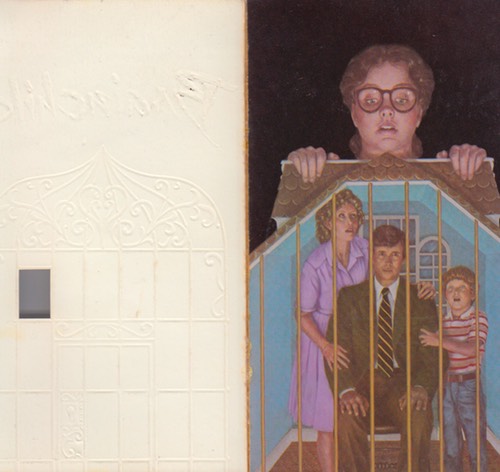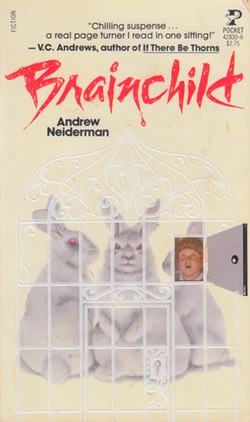Welcome to Freaky Friday, that moment at the end of the week when you put down your torches and pitchforks, exhausted after six whole days of pursuing mad scientists to the edge of cliffs where they have the choice of either leaping to their dooms or being burned to death by your angry mob, and just relax and read something for fun before picking up the tools of your liberation once more.
Do you know what’s wrong with America? We don’t got no STEM. In case you’ve been asleep while Japanese high school students have been doing fifth-dimensional geometry and Norwegian middle school students have been building particle accelerators during recess, STEM is: “A curriculum based on the idea of educating students in four specific disciplines—science, technology, engineering and mathematics—in an interdisciplinary and applied approach. Rather than teach the four disciplines as separate and discrete subjects, STEM integrates them into a cohesive learning paradigm based on real-world applications.”
It’s the future of global leadership and we suck at it. Our kids aren’t in the top 10 for math or science scores, and most of them can’t even name the 10 best Pokemons without pulling out their phones. Want to know why we’re so bad at STEM? Read that last sentence again: “Rather than teach the four disciplines as separate and discrete subjects, STEM integrates them into a cohesive learning paradigm based on real-world applications.” You know what that means? We need to encourage our kids to turn their homes into giant experiments where their parents and siblings are unwitting test subjects who have their behavior modified with electric shocks, that’s what it means. And Andrew Neiderman knew that before anyone.
Meet Lois Wilson, a high school senior. She’s “hygienic, but unconcerned about cosmetics or new hairdos” and she’s just used electroshock therapy to train a rat not to eat, then kept it awake until it is dangerously “disheveled.”
“One can see a clear relationship between the rat as it now exists and the slum dwellers in our inner cities,” she says calmly to her seven-year-old brother, Billy.

America, this is exactly the kind of student STEM needs! Clean, but plain. Not afraid of disheveled rats. Preoccupied with slum dwellers in our inner cities and the potential of electric shocks to alter their behavior. Lois Wilson is going places, and how! Currently she lives in the tiny Catskills town of Sandburg, NY but she’s been allowed to audit classes in behavioral science at the local community college, and she’s applied for a scholarship to MIT. Her dad’s so proud of her he’s converted the pantry into a tiny science lab where Lois can dishevel rats in peace.
The entire Gilbert family seem happy with their lives, but as any reader of fiction knows, no one is actually happy. Dad is the town’s pharmacist, fighting the recent arrival of a chain drugstore and losing. He had a stroke back when Lois was in tenth grade and now she views her father like a lesson out of a medical textbook. Mom finds her daughter’s lack of interest in going to proms and having nice hair off-putting no matter how hygienic she may be. Billy is probably about to start setting the neighborhood pets on fire the first time anyone turns their back. Add a STEM education to the mix, and things get volatile.
Most STEM kids will tell you they chose their educational path for the career opportunities or because of a deep love of science or because they want to be the global leaders of tomorrow, today. Lois chose hers because, “Power, Daddy …It gives me a sense of power.” Before you give Lois the benefit of the doubt on that one, we meet her friend, Barb. As per Stranger Things, Lois’s Barbara doesn’t get treated with the dignity she deserves. Or any dignity whatsoever. In the patronizing tones of a serial killer who finally has his favorite cheerleader immobilized on an operating table in his basement, Lois tells Barbara—and their undernourished male mascot, Bernie—that she’s going to conduct a behavioral science experiment that will eliminate their sex drives. All they have to do is be naked around each other all the time and soon they won’t care about sex at all. Barb and Bernie are hesitant until Lois points out that dogs don’t wear pants. With that, they both strip buck naked and Lois starts taking notes. Unfortunately, Barb’s mom is not convinced that STEM is our future and she undermines Lois’s education by blowing the whistle on the whole thing. Lois’s parents are mostly just astonished their daughter has a sex drive at all.
Humiliated, but determined to get outside her comfort zone during her senior year, Lois auditions for her first play, The Effect of Gamma Rays on Man in the Moon Marigolds, because it sounds like it was peer-reviewed. To her mom’s delight, she pushes herself hard and works on her audition monologue relentlessly, so it’s even more humiliating that her audition is such a massive train wreck she flees the auditorium with mocking laughter ringing in her ears. To hell with the arts! They can only hurt you. Defund the NEA! Lois is all about the STEM now!
At the local community college, Lois worships her teacher, Kevin McShane, because he’s the only adult who doesn’t immediately want her shot with tranquilizers and put in a zoo. Inspired by his lectures on the importance of experimentation in behavioral science, Lois has her brainstorm. Her family annoys her, so she’ll turn her entire home into one giant experiment and alter their behavior in the name of psychology! First, she turns Billy against their mom by destroying his well-loved pair of teddy bears and framing mama for the carnage. To avenge this heinous crime, she convinces Billy to steal mom’s favorite earrings. Things come to a head when Lois is awarded a full ride to MIT and the whole family goes out to celebrate. Only they don’t get very far because mom gets out of the shower, can’t find her earrings, freaks out, and dad is so upset he finally has his second stroke.
But a good scientist doesn’t see setbacks, she sees opportunities for knowledge. Now that her father is completely paralyzed and trapped in a hospital bed in the master bedroom, well, “Lois thought about her father upstairs in his room. He was like a large, one-celled animal with a man’s intelligence. What an object of study. What potential for understanding and developing concepts. She might do her greatest paper before she even entered college.”
20 pages later, Lois has taken over her father’s care completely, turned mom into a Valium-popping wreck who guzzles vodka by the gallon and stares numbly at the TV, terrified her daughter is going to speak to her. Billy has gone totally feral and started a worm business in the living room. Dad is trained to ring a gong whenever he wants food, something he can only accomplish with agonizing effort. When he resists, Lois wires his foot so she can give him electric shocks whenever he disobeys.
“I’ll have to make you cooperate,” she tells her immobilized father who can only communicate by blinking. “It’ll be for your own good. In the end, you’ll thank me.”
Andrew Neiderman, the author, has written 47 novels under his own name, most of them during the horror paperback boom of the ’70s and ’80s. He even wrote the book that became Al Pacino shout-fest The Devil’s Advocate. But everything he’s done has been overshadowed by the fact that he’s written more than 68 books as V.C. Andrews (once she was dead, of course). That’s not quite fair because Andrew Neiderman’s work is pretty great. If you haven’t read his PIN (the book that apparently sold Andrews on his talents) you need to pick up a copy ASAP because any book about two kids being raised by an inanimate anatomical teaching model that occasionally has sex with them deserves space on your bookshelf.
Neiderman loves to write about dysfunctional families and characters who are too smart for their own good, whether they’re small children (Teacher’s Pet), genetically engineered dogs (Night Howl), or STEM students (Brainchild) and Lois is one of his greatest creations. And one of his most annoying.
To Lois, her parents are nothing more than groups of cells that can be modified and manipulated to demonstrate the practical workings of psychological processes. She gave up on having an actual, non-scientific relationship with them years ago because they wouldn’t accept her for who she is: a genius. Instead they’ve insisted on treating her like a normal, non-genius kid who goes to a Montessori school or something. But she’s willing to work with what she’s got and while she won’t get any love out of the relationship, hopefully she’ll get a paper out of it.
But Lois is a victim of the classic tragedy of STEM kids: their accomplishments are annoying. Most parents would be thrilled to have such a dedicated daughter. Lois’s parents are either too paralyzed or too hammered to care. By the time Prof. McShane comes around for a home visit it’s clear that some people can only criticize. His community college brain doesn’t see a thrilling scientific experiment in progress. Instead, sees a living room full of rats and worms, naked mom standing around in the yard in a daze, everything soiled and painted a nauseating shade of green that Lois’s mother can’t stand, a house reeking of feces and the smell of unwashed dad, and Lois yabbering about how everyone wants to steal her research.
No, Lois, we just want you to care about cosmetics and hairdos.
 Grady Hendrix has written for publications ranging from Playboy to World Literature Today; his previous novel was Horrorstör, about a haunted IKEA, and his latest novel, My Best Friend’s Exorcism, is basically Beaches meets The Exorcist.
Grady Hendrix has written for publications ranging from Playboy to World Literature Today; his previous novel was Horrorstör, about a haunted IKEA, and his latest novel, My Best Friend’s Exorcism, is basically Beaches meets The Exorcist.










